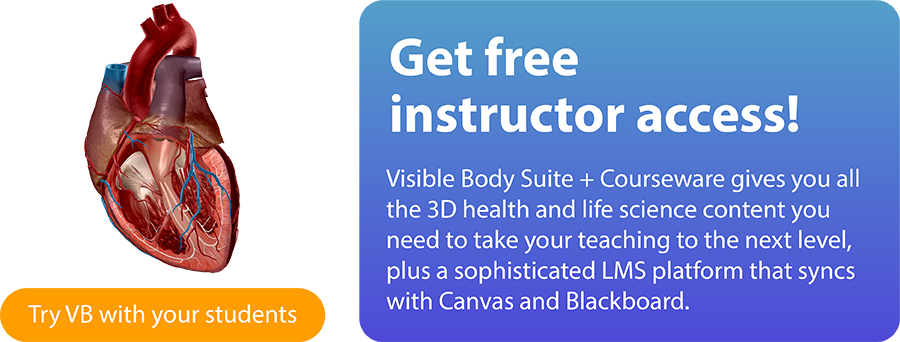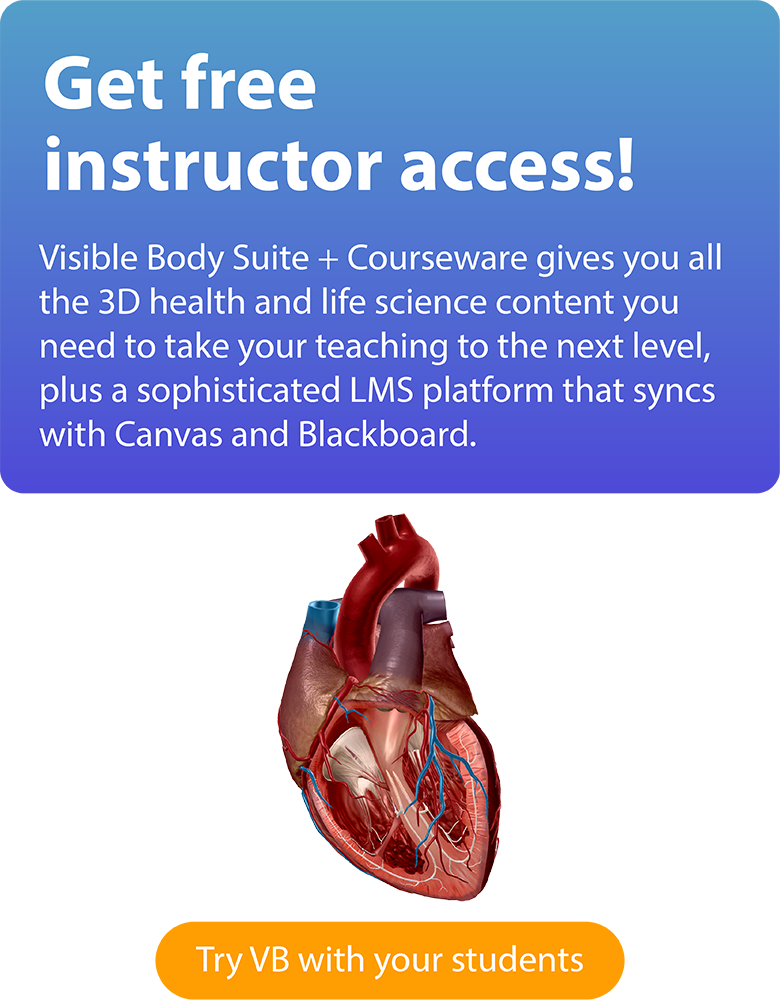Posted on 9/12/25 by Sarah Boudreau
As the world’s second leading cause of mortality, strokes are an important topic in allied health education. Visible Body’s vast library of content includes the 3D models, animations, and tools future healthcare professionals need to understand stroke pathophysiology.
In this blog post, we will take a visual tour of Visible Body content that instructors can use to teach the anatomical structures, physiological processes, and pathologies connected to strokes.


Ischemic stroke, which represents 87% of all strokes, occur when proper blood flow to the brain is blocked. To understand ischemic strokes, it’s necessary to understand the brain’s blood supply, and Visible Body Suite’s interactive 3D anatomical models help students visualize circulatory system anatomy.
Let’s start with the circle of Willis view. You can navigate to this view through the menu or by typing keywords into the Search tab.
Clicking on a structure—for example, the basilar artery—will cause the structure’s name and definition to appear in the info box. Here, you can hear the correct pronunciation of the structure’s name, read or listen to a textbook-level definition of the term, add a tag, and more.

Selecting and tagging the basilar artery (right side) in VB Suite.
Using the Systems Tray on the left side of the screen, you can add or remove entire body systems. For example, you could add the skeletal system to better understand the circle of Willis’s anatomical context, then remove it with one click to focus on the circulatory system once more.

Using the systems tray in VB Suite.
VB Suite’s annotation tools allow you to add notes and 3D drawings to your view. Using the Draw tool, you can mark the location of a stroke-causing clot.
 Using the draw tool in VB Suite.
Using the draw tool in VB Suite.
Hemorrhagic stroke makes up about 13% of all strokes and can be divided into intracerebral hemorrhage (occurring within the brain) and subarachnoid hemorrhage (occurring in the subarachnoid space between the arachnoid mater and pia mater, which are layers of the meninges).
We’ve already looked at some of the models and features that illustrate the brain’s blood supply, so let’s next look at the cerebrum and meninges cross section microanatomy model.
VB Suite’s microanatomy models provide a “zoomed in” view of small, intricate structures. In this microanatomy model, you can view the layers of tissue between the skull and the brain and their relationship to the cerebral arteries and veins.

Cerebrum and meninges cross section in VB Suite.
For a fuller understanding of the pathophysiology of strokes, let’s take another look at the circulatory system.
Atherosclerosis is a major cause of ischemic stroke. You can deepen your students’ understanding of this condition with VB Suite’s atherosclerosis microanatomy model and animation.

Atherosclerosis model in VB Suite.
Let’s zoom out. VB Suite’s interactive beating heart model allows you to adjust the BPM, show how electrical impulses move through the heart, and observe the movement of blood through the heart's chambers.

Adjusting the beating heart model in VB Suite.
For an in-depth look at the circulatory system, you can find a complete, interactive A&P course within VB Suite. From the main menu, click on Anatomy & Physiology and then click on Circulatory System to view the unit’s chapters and quizzes.

Adjusting the beating heart model in VB Suite.
Want to assign interactive 3D assignments and quizzes like this for credit? Check out Visible Body Courseware, the teaching and learning platform that harnesses VB Suite’s content for the classroom. Courseware allows you to assign premade or custom assignments, quizzes, and other content. It can be used on its own, or it can be integrated with your institution’s LMS!
If you enjoyed this blog post, you might also be interested in these lesson plans and other ideas from the Visible Body Blog:
Be sure to subscribe to the Visible Body Blog for more anatomy awesomeness!
Are you an instructor? We have award-winning 3D products and resources for your anatomy and physiology course! Learn more here.
When you select "Subscribe" you will start receiving our email newsletter. Use the links at the bottom of any email to manage the type of emails you receive or to unsubscribe. See our privacy policy for additional details.
©2025 Visible Body, a division of Cengage Learning